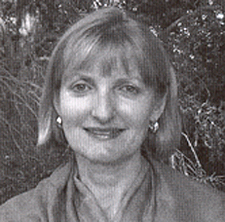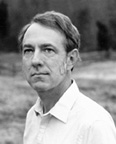An Irish High Priestess in India
By Lowell Thomas
Originally printed in the JULY-AUGUST 2007 issue of Quest magazine.
Citation: Thomas, Lowell."An Irish High Priestess in India." Quest 95.4 (JULY-AUGUST 2007): 131-133, 139.
This article is adapted from chapter ten of Lowell Thomas' book India: Land of the Black Pagoda, originally published in 1930. Some changes were made from British to American grammar to improve readability; otherwise this description is presented in its original form, reflecting the language, social structure, and customs of the times. Today, Madras is known as Chennai and Bombay is called Mumbai. Thomas had thought he would spend a month or two in India. Instead, he stayed for two years, leaving only when finances ran out, not because he wanted to. His guide as he traveled though India was not a native, but an Englishman, Major Francis Yeats-Brown, nicknamed Y. B., the author of The Lives of a Bengal Lancer.
Madras is the doyen of the British cities of the East Indies, dignified, delightful, and "somehow different." The black Tamil men with their long, straight hair gathered in a bunch at the top of their heads, carry umbrellas and fulfill to a nicety one's notions of the mild Hindu. The less opulent Tamils have noses like the beaks of birds. Their cheekbones are sharp. Their elbows are sharp. Their knees are sharp. Their bodies are mostly vein and bone, minus muscle and meat. They chew betel-nut which makes their teeth black and their lips red. They drink rice toddy, which makes them forget, temporarily, the nightmare that their lives must be.
But high-caste Madrasi people and prosperous untouchables become sleek in appearance and oval in shape, especially the women. Their dress consists of a long strip of cloth draped gracefully about the figure, showing their perfectly molded torsos from hip to breast like a column of burnished copper. They are hung, and placqued [covered], and laden with gold. If Ghengis Khan had seen the population of Madras nobody could have restrained him.
The burra sahibs, the captains of industry of Madras, are contentedly rich. They haven't the money-fever of Calcutta or Bombay. Every white man in Madras lives like a gentleman, with a "flivver" and a share in a sailing yacht. It is a city of great distances and a great many clubs. The Madras Club is one of the finest in Asia and their sheep's-head curry is a dish for Lucullus. Then if Lucullus desires he may repair to the Golf Club to correct his liver.
There also is a boat club, a gymkhana club, and the Adyar Club. What with bathing, boating, tennis, polo, golf, dancing, and dining at his five clubs, the "white man's burden" is very cheerfully borne here.
Every traveler should pay a visit to the Victoria Institute, where he will find excellent and moderately priced examples of the indigenous industries of a province where master craftsmen survive and art is still a living reality. Every province has now an exhibition of arts and crafts, but none is better managed than that of Madras.
The climate of Madras is certainly sticky, but it has never, during our three visits, been so bad as the orchid-house moisture of Bombay. There is plenty to see. Georgetown, Elihu Yale's church, the Cathedral of St. Tomo [St.Thomas], and the High Court, built in the Hindu-Saracenic style of thirty years ago, are all "worthy of inspection," as the painstaking guide-book says.
But it is at evening on the Adyar that the true spirit of the city speaks. The rippling river, the graceful palms against the evening sky, the cool breeze from the sea, the greenness, the peace of this suburb, are unrivaled in any of the great cities of India. The traveler will like Madras although he may not fancy Bombay and Calcutta, the other two presidency cities.
By a window overlooking the Adyar River sits an aged woman with silvery white hair. She sits cross-legged, in Eastern fashion, on a masnad [a small ceremonial rug]. Behind her is an embroidered bolster. Over the masnad is spread a Persian rug. She is dressed in white shawls with a border of royal purple, and the surroundings are as unmistakably Indian as her appearance is Irish.
Why does she sit here, like an Eastern queen? The answer to this question is a romance difficult to parallel in this materialistic age. This woman, who has long passed threescore years and ten, is an authoress, editor, orator, political leader, and the head of a religious movement whose forty thousand adherents are to be found in every quarter of the world.
As an authoress she has made her mark wherever the wisdom of the East is studied. As an editor, she has, through her paper, New India, a faithful public. As an orator she holds great audiences wherever she goes. Among the learned bodies she has addressed is the grave and ancient Sorbonne. As a political leader she has bitter enemies, and followers who idolize her. More than half a century ago, when scarcely out of her teens, she was the wife of an Anglican clergyman. She became a Roman Catholic, and left him. Then she became an agnostic and for several years worked in close association with the English reformer, Charles Bradlaugh. During this time she was an energetic materialist. Then she met Madame Blavatsky, the Russian spiritualist, and with characteristic courage threw her old opinions overboard. From earnestly believing nothing she came to believe almost everything, with equal enthusiasm! She gave up her work in London, where she had gained a reputation as an able speaker and a trenchant writer on social problems, and sailed for the East. From that time she has been a loyal disciple of Blavatsky.
In India she had to make her life anew. First she settled in Benares. Later she moved to Madras, and on Colonel Olcott's death she was elected the second president of the Theosophical Society, a post which she has held from that day to this, having been twice reelected.
This is her life-story in baldest outline. To tell of her trials and successes, of her friends and enemies, would need a volume. She is Irish and—saving her presence—she enjoys a fight. But she wouldn't admit this for a moment. Always she tries to turn the other cheek, but at times the ancient Eve will out. . . . She is a very gentle lady. There is nothing small about her. She never did a mean thing in her life, we feel quite sure.
Of the wisdom of her activities there has been much question; of the purity of her motives, none. Nor can her ability be disputed, even by her enemies, of whom she has aplenty. Annie Besant is a world-figure.
At a time when big-whiskered undergraduates were wondering whether they dared follow Newman or not, a little slip of a girl (oh, the madman her husband must have been not to realize the treasure he held!), brought up in sheltered surroundings, gave up home and faith and husband, to follow the light of Truth, as she saw it. She had hardly any money. She earned her living by writing for the newspapers. Through slough of despond and over uplands of hope she followed the light she saw, until at last, after many ups and downs, it has brought her here, to Adyar.
She is a tireless worker. When the Indian dawn is breaking over the Bay of Bengal, she is to be found sitting here just as we found her, cross-legged, surrounded by her work, writing, planning, dealing with the letters her secretary brings her, giving instructions to the officers of the Theosophical Society, giving advice to aspirants to the "kingly wisdom" and "kingly mystery," administering affairs that not only circle the earth, but "step from star to star."
Mrs. Besant has none of the false modesty of the unknown. She has seen too much of the world to object to facing the camera. Yet she has none of the airs of a high priestess, none of the moods of a mystic. She is simple and direct, a person of singular charm. Her favorite mottoes probably are: "For God, for King and Country," and "There is No Religion Higher than Truth": for these two adorn the walls of her room. Every one who knows her, not Theosophists only, will tell you that she has lived these ideals throughout her strenuous and striking career. Among her followers (many of whom, by the way, believe her to be an incarnation of the famous Italian philosopher, Giordano Bruno) she is believed to be rather a despot (and they surely need to be galvanized with the fear of God occasionally, for like all such bodies this one contains a proportion of people that the world would call cranks, or something harsher), but to us outsiders, she is a delightful, soft-spoken, cultured old lady. And in her bright brown eyes there is a hidden fire.
The objects of Mrs. Besant's colony at Adyar, and of Theosophists at large, are described to us as both spiritual and practical. The spiritual side is rather difficult to explain in a paragraph, but briefly it is (a) to promote the brotherhood of man, (b) to study comparative religion and philosophy, and (c) to explore the hidden powers latent in man. Practically, members can believe what they like. They can be Hindus or Holy Rollers, Buddhists or Baptists. "There is a good deal of difference of opinion on matters of doctrine," said Mrs. Besant, "and I think that this is a very healthy sign. Unless we have differences of opinion on matters of doctrine we shall inevitably become a church or sect. It is not our business to become either, for we are a society of students, and if all students agree there will be a very poor advance."
But the common denominator for the average Theosophist seems to be a belief in Karma. Karma is "the good law," whereby every action in this world has its inevitable consequence, or reaction. In other words, in this life or succeeding lives, each shall reap as he has sown. Gradually through the experience of countless births, the soul learns the lessons of Karma and attains to the "kingly wisdom and the kingly mystery of the unborn, undying, unbegun." It then leaves the earth, to seek expression in some other flesh. . . .
As to the inner or esoteric section, their beliefs may be crudely summarized as follows, by outsiders who are not initiated into their secrets: Each age of the world, from the æon-long past of the Lemurians, who lived on the banks of the Mediterranean, and the Atlanteans, whose civilization sank beneath the ocean waves in far centuries of geologic time, has had a Manu, or typical Man, who sets the example to humanity for the race that is to come and strikes the keynote of its religion. The Manu of this age, say these Theosophists, is the Lord Gautama Buddha. But they believe the world to be now on the threshold of a new age. The new world-teacher, the successor to Buddha, is soon to come, to give light and leading to the world. The day of the Messiah is at hand. Already a herald of the great teacher has come in the body of a Brahmin youth, young Krishnamurti, known to the elect as "Alcyone." His is a thoughtful, beautiful face, with the eyes of a mystic.
A gentle-voiced American, in horn-rimmed glasses, takes us to see the practical work that the Theosophists are doing in Adyar. His costume, consisting of a purple skull-cap, a white shirt worn with the tail out, and a white loincloth, makes it difficult for us to believe that he was a resident of Madison, Wisconsin, not long ago, and an instructor in the university there. All the Occidentals at Adyar—British, American, French, Scandinavians, and others—adopt the cool and comfortable garments of Hindustan. Many have taken high university degrees in Europe, but they wear dhoties none the less.
On our way to the Theosophical Publishing House, we pass Mrs. Besant's Rolls-Royce-the gift of an Indian maharajah-waiting to take her to the city offices of her daily paper, New India. At the Publishing House we see learned Sanskrit works, and well-bound books in English, which are being distributed to the four points of the compass. We continue our stroll around the two hundred and sixty acres of the domain, which contains some two hundred Theosophists. We pass Leadbeater Chambers: the Seva Ashrama, which is the headquarters of the Order of the Brothers of Service—a sort of corps d'eite of Theosophists, vowed to poverty and obedience, and numbering twenty-five members who have renounced all worldly possessions to work for their order: the Annie Zoroastrian Home: Miss Bell's bungalow: the Olcott bungalow, where the first president lived: the Masonic Temple: the workshop: the power-house: the dairy and students' quarters, where a successful agricultural school has been started: and the Vasanta Press, where a monthly and a weekly magazine and many books are printed.
Then back to headquarters. Still we have seen nothing of education. The society maintains five schools in England, three in Scotland, and a thousand pupils in Ceylon. Locally, the Olcott-Panchama schools were pioneers in the work of educating the depressed classes of Madras Presidency and continue to do an immense amount of good.
There are some fifteen hundred branches of Theosophists scattered throughout the world. Even Iceland has its lodge, named "Jolabladid." In Java a group of devout Dutchmen meet for the purpose of promoting "abstinence from gambling, opium, alcoholic liquors, debauch, slander, lying, theft, and gluttony."
America now has about twenty thousand members. But the strongest claim that Adyar can make on the gratitude of the world, is its library of palm-leaf manuscripts. Here are shelves and shelves of ancient rolls, written by the monks of Tibetan monasteries and the pundits of the Ganges plains. It contains the garnered wisdom of elder civilizations, this library. There is an atmosphere of perfect peace here—where Pierre Loti studied twenty years ago—something of the quiet heart and level eyes of the Asian mystics. In the work of translating and classifying these manuscripts a group of learned Brahmins are engaged, and although the work progresses slowly from lack of funds, still it does progress. Slowly but surely the knowledge of long ago, which would have been one with the all-consuming dust of India but for the enterprise of Adyar, is being brought in print to Western eyes. Who knows what treasures of vision these pundits may unlock?
Here then in Adyar, and elsewhere, is a society of persons, the Order of the Star in the East, waiting and working for the coming Manu. "The striking of His hour is nigh when He shall come to mankind again as He did so often in the past." And we, who see but as in a glass darkly, can yet give our respect to an earnest band of workers who are preparing for the Kingdom that is to come, as they believe, in the days that are near at hand.



 Pedro Oliveira
Pedro Oliveira Linda Oliveira
Linda Oliveira Let me propose a thought experiment. Imagine, if you will, that there's a certain clump of nerve cells in the brain that's essential for conscious awareness. Now suppose that a certain drug suppresses neural activity in just this nucleus, with no effect on the rest of the brain. Subjects who take this drug do things as usual, but they experience nothing. The drug converts them into sleepwalkers. Finally, imagine that I've developed a new form of this drug, which has permanent effects. It abolishes consciousness forever, with no effect on behavior. I want to test it on you. How much will you charge to take it?
Let me propose a thought experiment. Imagine, if you will, that there's a certain clump of nerve cells in the brain that's essential for conscious awareness. Now suppose that a certain drug suppresses neural activity in just this nucleus, with no effect on the rest of the brain. Subjects who take this drug do things as usual, but they experience nothing. The drug converts them into sleepwalkers. Finally, imagine that I've developed a new form of this drug, which has permanent effects. It abolishes consciousness forever, with no effect on behavior. I want to test it on you. How much will you charge to take it?